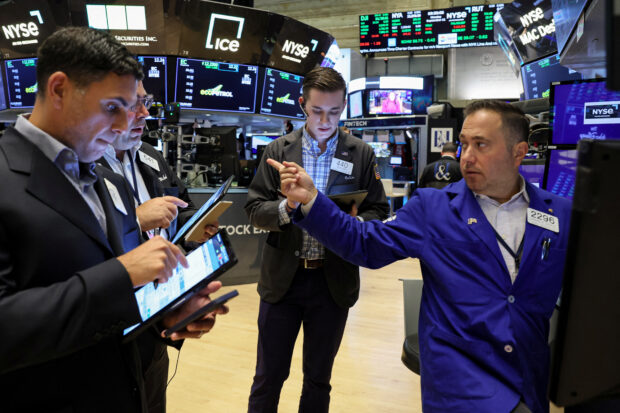Wall Street advances as bond yields fall, investors digest Fed minutes

Traders work on the floor of the New York Stock Exchange (NYSE) in New York City, U.S., Sept 11, 2023. REUTERS/Brendan McDermid/File photo
Wall Street’s major indexes closed higher after Wednesday’s choppy session with the release of minutes from the U.S. Federal Reserve’s last meeting showing caution among policy makers that helped fuel investor hopes that rates would stay steady.
Fed officials pointed to uncertainties around the economy, oil prices and financial markets as supporting “the case for proceeding carefully in determining the extent of additional policy firming that may be appropriate,” according to the minutes released on Wednesday from the Sept. 19-20 meeting.
Trading was choppy on Wednesday with all the indexes starting off the session with gains before turning lower ahead of the minutes and then regaining lost ground to push higher.
Along with recent moves in interest rates and dovish comments from Fed officials in the last few days, Angelo Kourkafas, senior investment strategist at Edward Jones, said the minutes appeared encouraging for investors.
READ: Fed officials turned more cautious in Sept as economic uncertainty grew
Article continues after this advertisement“Today’s release highlights the risk of over-tightening, and knowing what has happened over the past three weeks with interest rates, that provides some comfort to investors that we’re not going to see another rate hike,” said Kourkafas.
Article continues after this advertisementBut he noted that upcoming Fed decisions will take into account consumer price index (CPI) readings for September, due out on Thursday before market open, as the Fed‘s “data dependence hasn’t gone away.”
Earlier on Wednesday, data showed that U.S. producer prices increased more than expected in September amid higher costs for energy products, but underlying inflation pressures at the factory gate continued to moderate.
Top gainers
The Dow Jones Industrial Average rose 65.57 points, or 0.19 percent, to 33,804.87, the S&P 500 gained 18.71 points, or 0.43 percent, to 4,376.95 and the Nasdaq Composite added 96.83 points, or 0.71 percent, to 13,659.68.
The energy index fell 1.4 percent and was the weakest among the S&P’s 11 major industry sectors. It was dragged down by a 3.6- percent slump in Exxon Mobil shares after the oil and gas producer agreed to buy rival Pioneer Natural Resources in an all-stock deal valued at $59.5 billion. Pioneer shares closed up 1.4 percent.
The biggest gainers were rate sensitive sectors, real estate, which added 2 percent and utilities which finished up 1.6 percent as Treasury yields fell.
U.S. Treasury yields on benchmark 10-year notes fell to a roughly two-week low, as prices rose on safe-haven flows as a war in the Middle East still raged after a deadly weekend attack by Hamas on Israel.
READ: U.S. stocks futures slip, oil surges on Middle East violence
Israel continued to pound Gaza with retaliatory air strikes, which has killed scores of civilians, as it formed an emergency unity government on Wednesday and its army said it killed three Hamas militants.
Birkenstock IPO
Scuffing Wednesday’s mood was the latest initial public offering (IPO). Birkenstock Holding shares closed down 12.6 percent at $40.20. In its first day trading on the New York Stock Exchange the German footwear company’s shares never touched their IPO price of $46.
Drugmaker Eli Lilly gained 4.5 percent following the early reported success of Danish rival Novo Nordisk’s Ozempic in a trial to treat kidney failure, while dialysis firms DaVita and Baxter International slumped 16.7 percent and 12.3 percent, respectively.
Advancing issues outnumbered declining ones on the NYSE by a 1.65-to-1 ratio; on Nasdaq, a 1.19-to-1 ratio favored decliners.
The S&P 500 posted 12 new 52-week highs and 10 new lows; the Nasdaq Composite recorded 44 new highs and 206 new lows.
On U.S. exchanges 10 billion shares changed hands compared with the 10.7 billion average for the last 20 sessions.